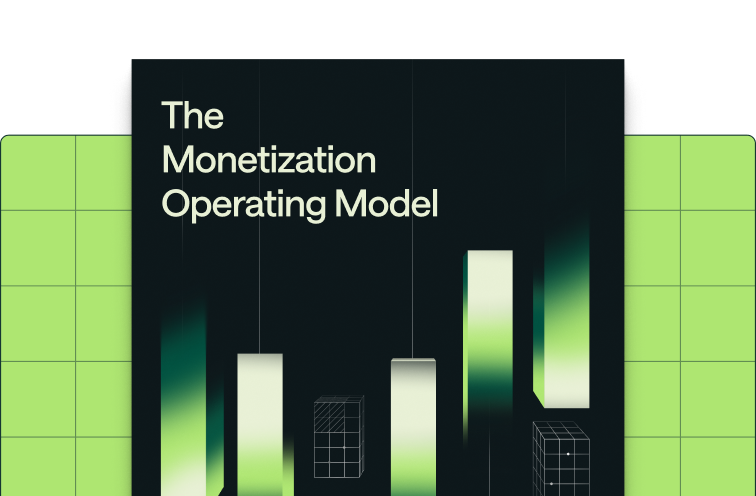Share
Most SaaS companies realize their pricing is broken when engineers spend 40% of their time debugging billing instead of shipping features, finance can't forecast next quarter's revenue, and every pricing change requires a three-month engineering project.
The wake-up call happens differently for every company. Sometimes it's a CFO who can't close the books because usage data doesn't reconcile with revenue recognition. Sometimes it's a VP of Engineering watching senior developers debug invoice calculations at 2AM instead of building competitive features. Sometimes it's a Product Manager who can't launch AI features because the billing system can't handle token-based pricing.
The problem is infrastructure constraints, not strategy decisions.
The best pricing model depends on having infrastructure that lets you evolve pricing as fast as you ship product, because customer value patterns change and your monetization needs to keep up.
Most companies pick pricing models based on what their billing system can handle rather than what customers actually value. Legacy systems force false binary choices that have nothing to do with optimal strategy and everything to do with technical limitations.
This guide breaks down the six SaaS pricing models that actually work in practice, why infrastructure constraints are the real bottleneck, and how to build a monetization system that scales with your product velocity.
{{widget-monetization-whitepaper}}The 6 SaaS pricing models that actually work
Modern SaaS pricing has six distinct approaches that work in specific contexts. The key is matching your approach to how customers realize value, not what your current billing system happens to support.
Each model succeeds when it aligns with customer value delivery patterns:
- Usage-based pricing works when value scales directly with consumption: OpenAI processes billions of API calls with transparent token pricing that customers can predict and control
- Hybrid subscription-plus-usage gives predictable base revenue with expansion upside: base subscription for platform access plus usage-based charges for consumption beyond included limits
- Tiered pricing serves different customer segments simultaneously: Slack uses Free, Pro, Business+ structures to capture SMB to enterprise value in one system
- Outcome-based pricing ties charges to business results delivered: performance marketing tools charge based on conversions generated, not clicks served
- Per-seat models remain effective when value comes from user access, but break when usage varies dramatically across similar accounts
- Credit systems provide enterprise predictability while maintaining usage flexibility
The failures happen when companies force customers into pricing structures that don't match how they actually use and benefit from the product.
1. Usage-based pricing: value scales with consumption
Usage-based pricing works when value scales directly with consumption. Customers pay for what they actually use: API calls, compute hours, data processed, or transactions completed.
OpenAI processes billions of API calls with transparent token pricing that customers can predict and control. Their pricing model perfectly reflects the reality that some customers generate 10 API calls per month while others generate 10 million. The billing matches the compute resources consumed and value delivered.
Usage-based pricing eliminates the mismatch where light users overpay and heavy users get subsidized. When pricing reflects actual consumption, customers see bills that match the value they receive, building trust and encouraging natural expansion.
Implementation requires real-time usage tracking, flexible rate calculations, and customer dashboards showing consumption patterns and projected costs. Without transparency tools, customers experience bill shock and support tickets spike..
2. Hybrid subscription-plus-usage: predictable base with expansion upside
Hybrid models give you predictable base revenue with expansion upside. Customers pay a subscription for platform access plus usage charges for consumption beyond included limits.
Databricks' DBU (Databricks Unit) model combines committed spend with overage pricing. Customers commit to annual minimums that provide cash flow predictability while paying for additional consumption that scales with their success.
This approach works for products that deliver both access value (platform capabilities) and consumption value (data processing, AI features, or transaction volume). The subscription covers core functionality while usage charges capture expansion as customers grow.
Microsoft Copilot uses this model: $30 per user for baseline capacity plus additional credits for usage spikes. This reduces adoption risk while capturing revenue from power users without budget renegotiation.
3. Tiered pricing: serving multiple segments simultaneously
Tiered pricing serves different customer segments simultaneously. Good, Better, Best structures help you capture SMB to enterprise value in one system.
Platforms like Slack use Free, Pro, Business+ structures that scale features, usage limits, and support levels. Each tier targets different customer segments with appropriate feature sets and pricing levels.
The key is designing tiers around customer segments, not internal feature categorization. Small teams need basic functionality with predictable costs; enterprises need advanced features, higher limits, and dedicated support.
Successful tiered pricing requires clear value differentiation between levels. Each tier should feel like the right choice for its target segment, not a compromise forced by pricing constraints.
4. Outcome-based pricing: charges tied to business results
Outcome-based pricing ties charges to business results delivered rather than features accessed or usage consumed. Customers pay when your product moves their business metrics.
Performance marketing tools charge based on conversions generated, not clicks served. Recruitment platforms charge per successful hire, not per job posting; customer support AI charges per ticket resolved, not per API call.
This model removes adoption risk for buyers and aligns your revenue with their success. When customers achieve measurable results, they pay accordingly; when results fall short, so does your revenue.
Implementation requires clear outcome measurement, attribution systems that prove your solution caused the results, and pricing formulas that convert achievements into payments. Both parties need transparent tracking and agreed-upon success definitions.
5. Per-seat models: when value comes from user access
Per-seat models still work when value comes from user access rather than consumption patterns. Project management tools, CRM systems, and communication platforms deliver value through team collaboration and individual productivity.
The model breaks when usage varies dramatically across similar accounts. If some teams use the platform intensively while others barely log in, flat per-seat pricing creates value misalignment.
Smart per-seat implementations include usage monitoring and expansion triggers. When teams consistently exceed usage expectations, automatic upgrade prompts or overage billing captures additional value.
6. Credit systems: enterprise predictability with usage flexibility
Credit systems let enterprise customers prepay for usage credits, then consume them as needed throughout the budget cycle. This gives finance teams spending certainty while preserving operational flexibility.
Credits solve the enterprise procurement problem: finance approves one annual purchase order instead of wrestling with variable monthly invoices. Teams consume credits based on actual workload demands without additional approvals.
Windsurf offers seat-based plans that include 500 credits per user per month, with pooled add-ons available for additional capacity. This structure provides predictable per-user costs while enabling usage-based consumption patterns.
Implementation requires real-time credit tracking, customer-level aggregation, and contract-aware systems with configurable burn rules. Customers need visibility into remaining balances and usage optimization recommendations.
Why most pricing decisions are actually infrastructure constraints
Legacy billing systems force binary pricing choices that have nothing to do with customer value and everything to do with technical limitations. These systems require you to pick one approach and stick with it, regardless of what customers actually value.
Modern products deliver both access value and consumption value, but legacy systems force you to choose subscription or usage instead of supporting hybrid models that optimize for both.
The false choice problem
Products are now expected to deliver both access value and consumption value, but legacy systems were built for subscription models and struggle to support usage-based pricing without significant custom development.
Legacy billing systems were built for subscription models and require significant engineering work to add usage metering, dynamic pricing, and hybrid model support. Companies have to build custom development around existing subscription systems to support usage-based pricing effectively.
Then, they end up with suboptimal pricing because their billing system can't support their ideal strategy without major custom development. Modern products need pricing flexibility that adapts to customer segments and product evolution, not infrastructure limitations.
This creates a cascading constraint where technical limitations dictate business strategy. You choose pricing models based on what your infrastructure can handle rather than what creates optimal customer value.
The engineering tax that kills growth
Custom billing infrastructure turns your best engineers into billing maintenance specialists instead of product builders.
Without a modern system, every pricing change becomes a three-sprint project that delays product features because billing logic lives everywhere in your codebase. Product teams ship features weekly, but implementing pricing for those features requires months of custom development, cross-team coordination, and manual workarounds.
Revenue risk makes everything untouchable. Nobody wants to be the engineer who broke billing and lost monthly recurring revenue; this creates technical debt that accumulates over time as teams implement workarounds rather than fix underlying architecture problems.
Senior engineers didn't join your company to debug invoice calculations at 2AM. This creates retention problems with your best talent as they get pulled away from interesting product challenges to maintain billing infrastructure.
Engineering teams become the catch-all for billing system failures and customer billing disputes instead of focusing on core product development. When customers can't understand their usage charges or billing errors create support tickets, engineering gets the escalation.
The operating model that actually scales modern monetization
Successful monetization requires ten integrated capabilities working together as a system. Having 5 out of 10 creates gaps that undermine growth, but all 10 together create a systematic advantage that compounds over time.
Modern monetization requires systematic approaches rather than isolated pricing strategies. It requires a system that aligns people, process, and platform around shared strategy. Companies that build this foundation turn pricing changes from quarterly projects into daily product decisions.
The 10 Capabilities Every Monetization System Needs
These capabilities work together as an integrated system where gaps in any area undermine the others. Having all ten enables systematic growth that scales with product velocity:
- Self-serve pricing and billing for product teams: Launch pricing for new products, plans, or features in minutes with configurable logic for usage, agents, seats, tokens, or outcomes, without involving engineering
- Safe, flexible pricing experimentation: A/B test pricing models across customer segments, use feature flags for progressive rollouts, and enable safe rollbacks with version-controlled pricing plans
- Systematized pricing logic with rate cards: Manage pricing dimensions centrally, SKUs, units, thresholds, tiers, overages, with configurable rate cards by customer type, plan, region, or delivery model
- Direct connection between value measurement and billing: Product events like API calls, agent invocations, or workflows completed are metered in real-time and mapped automatically to SKUs and customer entitlements
- Visualized and communicated product value: Customer-facing dashboards show usage and outcomes tied to pricing, while internal reporting links feature usage to account health and revenue
- Transition support for results-based and hybrid models: Run multiple pricing models in parallel, seats in one product, usage in another, outcomes in a third, with smooth migration tooling and contract flexibility
- Shared visibility into pricing structure and performance: A centralized source of truth for pricing logic provides live reporting on revenue, usage, and margin by product, customer, and pricing plan
- Version control and pricing governance: Version-controlled pricing plans with change history, clear approval workflows, and audit trails ensure every change is logged and attributable
- Unified data platform as a source of truth: Centralized platform captures usage, pricing, and billing events with standardized data models and real-time reconciliation across all systems
- Cross-functional alignment across product, finance, GTM, and engineering: Clearly defined ownership for pricing decisions with shared frameworks, common language, and connected workflows that prevent handoff gaps
Companies that build these capabilities systematically turn pricing changes from quarterly projects into daily product decisions.
People, Process, Platform Integration
The operating model succeeds through coordinated investment across organizational structure, operational processes, and technical infrastructure working together as an integrated system.
The three pillars that enable systematic monetization include:
- People: Someone owns the monetization system end-to-end: This person coordinates value definition, packaging, delivery, and measurement across teams, preventing cross-functional bottlenecks
- Process: Pricing as continuous product development: Research → Iterate → Test → Launch → Measure cycles with version control, A/B testing, progressive rollouts, and rapid iteration based on customer feedback. This means treating pricing changes like feature releases with testing, staged rollouts, performance monitoring, and the ability to iterate based on customer feedback and business metrics
- Platform: Infrastructure that supports any pricing model without engineering overhead: Decouple pricing logic from product development so business teams can update rates, add SKUs, or modify billing rules without code
Most companies are missing at least two of these components entirely, creating instability that prevents systematic growth. Companies that get all three components working together charge effectively and win faster with aligned incentives and predictable revenue growth. Pricing becomes a growth multiplier when properly implemented rather than an operational constraint.
How AI breaks traditional SaaS pricing
AI fundamentally changes the pricing game because it performs work autonomously rather than providing access to tools. Most existing billing systems can't handle this shift to value delivery that scales unpredictably with usage intensity.
AI products can scale from zero to massive usage almost overnight. Without a well-designed pricing model in place, sudden adoption can lock you into unprofitable terms. You need billing infrastructure that can handle scale immediately.
AI infrastructure costs are real and negative gross margins happen quickly. When you under-price AI, your best customers become wildly unprofitable; unlike subscription models where marginal costs are minimal, AI consumption directly correlates with compute expenses.
You can't leave legacy customers on old pricing when serving costs are higher than revenue; unprofitable revenue forces pricing resets across your entire customer base, creating backlash risk if not handled carefully.
AI companies need billing systems that process millions of events per second with real-time usage tracking and rapid pricing updates tied to compute costs. Traditional billing systems built for monthly subscription cycles can't handle this operational complexity.
OpenAI's pricing evolution demonstrates this necessity: an 83% reduction in token costs over 16 months as models improved and competitive pressure increased. This level of pricing velocity requires infrastructure that can handle rapid rate changes without breaking customer relationships or billing operations.
AI companies need billing systems that process millions of events per second with real-time usage tracking and rapid pricing updates tied to compute costs. Traditional billing systems built for monthly subscription cycles can't handle this operational complexity.
The winners are companies that treat AI billing as infrastructure from day one rather than trying to retrofit subscription systems for usage-based models. Purpose-built systems enable the pricing agility that AI businesses require.
Building your pricing implementation strategy
Success depends on matching your pricing approach to how customers realize value, how they budget software, and having infrastructure that can evolve with your business without technical constraints.
The framework starts with understanding value delivery patterns and choosing appropriate pricing elements:
- When customer value scales with consumption (API calls, compute hours, data processing), usage-based pricing with transparent consumption tracking creates perfect alignment
- When value comes from platform access (project management, CRM, communication), subscription models work but should include usage tiers for variable consumption
- When products deliver both access and consumption value, hybrid models optimize for all segments with predictable base costs plus usage expansion
Enterprise products need hybrid approaches that support both predictable budgeting and variable consumption patterns
The key is infrastructure that handles multiple pricing elements without forcing you to rebuild systems as your strategy evolves. When pricing infrastructure is flexible, you can adapt to changing customer needs and market conditions rather than being constrained by technical limitations.
Start with your customer value delivery pattern, then choose pricing elements that align with how customers realize and budget for that value. Build or choose billing infrastructure that supports your optimal strategy rather than forcing strategy decisions based on technical constraints.
Modern monetization focuses on building systems that enable continuous optimization as your product and market evolve.
Ready to build a monetization system that scales?
The companies that will win are those that view monetization complexity as a strategic advantage rather than an operational burden; they'll build systems that turn pricing agility into a growth engine while competitors struggle with billing constraints.
The choice is clear: invest in monetization infrastructure that scales with complexity, or watch competitors pull ahead while you're still fighting your billing system.
Ready to dive deeper? Our comprehensive whitepaper "The Monetization Operating Model" explores how leading companies are building infrastructure to support dynamic pricing at scale. Get practical frameworks for aligning people, process, and platform around modern monetization strategies.
{{widget-monetization-whitepaper}}





.avif)


.png)

